Sunday, September 22, 2019 / 08:00AM / by Proshare Research / Header Image Credit: Proshare Graphics
"Banking is a very treacherous businessbecause you don't realize it is risky until it is too late. It is like calmwaters that deliver huge storms." - Nassim Nicholas Taleb
The inherent risks inbanking makes it a business of the desirable, the probable and the possible.Banks make money sweat by converting it into productive action which come fromideas that are designed to produce more money (the so called cash-to-cash cycle).The idea-to-action-to-money loop is imperfect but brilliant when its works. InH1 2019 Nigerian banks found it increasingly difficult to close the loop astheir gross earnings either grew marginally or declined and where banks showedsignificant growth, such advance in top line income did not necessarily trickledown to their corporate bottom lines.
Section 1 of this report takes a bird's eye view of theNigerian banking sector's corporate performance between H1 2018 and H1 2019.The banking sector has had a rather rough period between H1 2018 and H1 2019 aspost recessionary economic growth in the country has remained muted mainlyleading to higher rates of delinquent assets and loan loss impairmentprovisions. In 2018 the banks took advantage of day one IFRS9 adjustments toimprove their bottom-line earnings but this accounting adjustment would not beavailable in 2019, meaning that banks will need to keeper tighter loan books asrisk management takes centre operational stage. The irony here is that theCentral Bank of Nigeria's (CBN's) instruction for banks to maintain a loan todeposit ratio (LDR) of 60% by September 30 2019, has meant that a number ofbanks will need to increase lending in an economy plagued by slow grossdomestic product (GDP) growth (1.94%), reduced corporate manufacturing marginsand weak domestic consumer demand. Top line gross earnings growth hasbeen weak for banks as overall business conditions have been underwhelming.Bottom line growth, however, has done better as a few banks reduced their costto income (CIR) ratios. Despite the fall in CIR for some banks, other bankshave had difficulties taming costs and have found themselves with CIRs wayabove the industry median of 93%.
Section 2 takes a deep look into prominent industry numbersacross banks and highlights the nuances within the sector according to banksize, strategy and history. Larger tier one banks have done well in growingtheir assets and earnings but not all big banks have been able to squeezestrong bottom line earnings growth from operating income in H1 2019.
Section 3 provides a deeper dive into each bank's H1 2019results to see how well the bank did in the period under review. The analysishence underscores the differences amongst bank performances and highlights someof their operational similarities. The section peels back the layers ofreporting for profitability, asset quality, liquidity and leverage.
Section 4 looks at bank strategies from a number of genericperspectives and reviews the imperatives of emerging customer aspirationalservice experiences that will shape new business paradigms in the near future.
Section 5 Analyses how information technology will likelyredefine the borders of banking as a service and set the tone for the newtech-based financial order. The section explains how information technologywill shave down the borders between payment /settlement services,lending/borrowing solutions and B2C, B2B, G2B and even G2G on- line real-timedigital experiences between customers'/transaction parties working and livingon-the-fly.
Section 6 deals with issues of integrity and leadership.Going forward the primary tradeable asset of a financial vendor will be itsintegrity and credibility, reputational capital will be in high demand as transactionsshift from brick and mortar to the digital plain.
Section 7 concludes the report and explainshow the dynamic evolution of the payment/settlement and lending ecosystem willcreate a new behavioural paradigm for the provision and consumption offinancial services and how this dynamic transition will likely have an impacton the size and composition of corporate financial incomes over the next fewquarters.
Section 8 addresses the issue of methodologyand explains that a time series approach was adopted with some cross sectionalanalysis that compared individual bank performances. The non-quantitativeaspects of the reports analysis leaned on theory and observation of corporateactions and customer responses over time.
Section 9 Provides Links and References tofurther material that could be of interest and use to the reader ofthe report.
Section 10 Explains to users of the report theterms and conditions under which the report can be used
Section 11 Gives the research contact mails of the team thatput the report together. Members of the team can be contacted for furtherclarification of areas they may require further explanation or insight.
1.0 Introduction
The banking sector had a rough patch in 2018 as several depositmoney institutions (DMBs) saw a compression of operating incomes and aflattening of shareholder equity. Indeed, three DMBs (Unity Bank, Heritage Bank and Keystone Bank)saw shareholders fund turn negative or become more negative than in 2017. Thenegative equity positions may not have affected bank liquidity but it hascertainly eroded capital adequacy and loan to deposit ratios (LDRs) and put theinstitutions in a tough situation of looking for fresh investment capital in abearish equity market.
2019 has not proved substantially different than the previousyear. The banks that ended 2018 with negative shareholder's fund have seen nonew capital raise and their bottom-line earnings have remained negative for H12019.
1.1 The Top Line
Most banks saw top line improvements over the previous year 2018and this was expected as the economy shook off the recession trauma thatprevailed into 2017, by 2018 the economy had started to show some bounce andcompanies generally saw an improvement in their financials. For banks, thegrowth has been moderate as the economy is still fragile with latest data fromthe National Bureau of Statistics (NBS) suggesting a GDP growth for July 2019of 2.01%. Gross Earnings (GEs) across bank's listed on the Nigerian StockExchange (NSE) show promise of potentially stronger year-end numbers if theeconomy can keep growing at a rate above its recent 2%.
The largest GE in H1 2019 was that of ETI which achieved total earnings ofN405.2bn, followed by Zenith Bank with N331.6bn and FBNH with N294.2bn. Coming from therear Unity Bank had the lowest H1 2019 GE atN20.5bn, followed by N40.8bn by Wema Bank and Sterling Bank with N74.5bn (see chart1 below).
Chart 1 Gross Earnings of Selected Nigerian Banks H1 2019
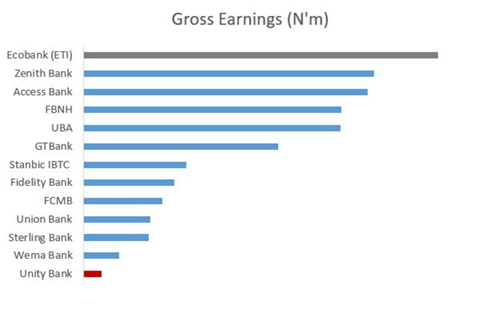
Source: Financial Statements of Selected Nigerian Banks H1' 2019, Proshare research
Interestingly, banks with the lowest GEs appear to have witnessed the largest growth between H1 2018 and H1 2019. Wema Bank, for example, saw its GE rise from N32.0bn in H1 2018 to N40.8bn in H1 2019, a growth of +27.5% year-on-year (Y-o-Y). Unity Bank's GE climbed from N17.5bn in H1 2018 to N20.5bn in H1 2019, representing a +17.5% upward kick Y-o-Y. Larger banks such as Ecobank saw H1 2018 GE skip from N384.6bn to N405.2bn in H1 2019, representing a forward thrust of a modest +5.4%. Indeed, one of the strongest Tier 1 brands GT Bank, saw its GE actually slip. GT Bank's GE dropped from N226.6BN in H1 2018 to N221.8bn in H1 2019, a fall of -2.1% (see Table 1 below).
Table 1 Gross Earnings (GEs) of Selected Banks H1 2018- H1 2019
| Gross Earnings | ||||
| Bank | H1'19 (N'm) | H1'18 (N'm) | % Change | |
| Access Bank | 324,376 | 253,024 | 28.20% | |
| Ecobank (ETI) | 405,202 | 384,588 | 5.36% | |
| FBNH | 294,231 | 293,336 | 0.31% | |
| FCMB | 89,786 | 83,925 | 6.98% | |
| Fidelity Bank | 103,655 | 92,295 | 12.31% | |
| GTBank | 221,870 | 226,632 | -2.10% | |
| Stanbic IBTC | 117,374 | 114,207 | 2.77% | |
| Sterling Bank | 74,499 | 77,608 | -4.01% | |
| UBA | 293,690 | 257,918 | 13.87% | |
| Union Bank | 76,017 | 83,333 | -8.78% | |
| Unity Bank | 20,547 | 17,492 | 17.47% | |
| Wema Bank | 40,835 | 32,034 | 27.47% | |
| Zenith Bank | 331,586 | 322,201 | 2.91% | |
| Source: Financial Statements of Nigerian Banks H1'2019 | ||||
1.2 The Bottom Line
The first half of the year 2019, was slow for banks as reflected in the modest growth of their GE, but apart from gross revenues coming short of desired levels, the after-tax profits for the banks were also unexciting, especially for banks with the largest GEs. Similar to the case of gross earnings, banks with lower GEs had larger growth in bottom line profits. ETI with the largest earnings for banks listed on the NSE in H1 2019 saw its profit after tax (PAT) rise from N51.5bn in H1 2018 to N59.5bn in H1 2019, representing a robust growth of +15.4%. FBNH's PAT, on the other hand, went from N33.2bn in H1 2018 to N31.7bn in H1 2019, reflecting a marginal drop of -5.4%.
Tier 2 Bank's represented an odd departure, Unity Bank with one of the lowest GEs in the sector saw bottom-line earnings soar by a strong +96.4% from N493m in H1 2018 to N968m in H1 2019. Wema Bank, another GE laggard, saw its profit after tax rise by a stiff +43.2% between H1 2018 and H1 2019. Wema and Unity Bank earnings growth are, of course, part of a 'low base' effect in which the two banks are springing up from significantly weaker positions a year earlier.
GTBank's earnings growth was a bit of a surprise as the bank's impressive brand equity projects a stronger underlying earnings performance than the +3.72% posted between H1 2018 and H1 2019. In a recent television interview, the banks managing director, Mr. Segun Agbaje, insisted that GTBank's management was less concerned with size than scale and shareholder value (see CBN Directive on Loan Defaulter: GT Bank CEO Segun Agbaje Shares Perspective), but with after-tax earnings crawling at just under 4% Y-o-Y, shareholders value looks increasingly tame, especially given the background of recently falling GEs.
The story of declining profits is wider than would have been expected, StanbicIBTC saw profit after tax slump by -15.9% between H1 2018 and H1 2019, with PAT dropping from N43.1bn in H1 2018 to N36.2bn in H1 2019. The fall in profit reflects the impact of the absence of a day 1 IFRS9 adjustment to the books. In H1 2018 Stanbic IBTC had a net impairment reversal on financial instruments of N5.5bn but in H1 2019 the reversal fell to N557m, the N5bn decline in write backs hurt the bank's reported bottom line earnings. In addition, another line item that drove the bank's PAT into slower growth was the N3bn increase in its other operating expenses which rose from N27.4bn in H1 2018 to N30.2bn in H1 2019, with depreciation and AMCON expense being major items.
Sterling Bank also saw its PAT squashed between H1 2018 and H1 2019. The bank's PAT slipped by -8.9% Y-o-Y, the main causes of the decline was a fall in trading incomes and a rise in operating expenses. Net trading income fell from N4.9bn in H1 2018 to N1.2bn in H1 2019; meanwhile the bank's other operating expenses grew from N7.5bn in H1 2018 to N8.8bn in H1 2019. (See table 2 below).
Table 2 Profit After Tax (PAT) of Selected Banks H1 2018- H1 2019
| PAT | |||
| Bank | H1'19 (N'm) | H1'18 (N'm) | % Change |
| Access Bank | 63,025 | 39,625 | 59.05% |
| Ecobank (ETI) | 59,492 | 51,552 | 15.40% |
| FBNH | 31,717 | 33,520 | -5.38% |
| FCMB | 7,530 | 5,726 | 31.51% |
| Fidelity Bank | 13,685 | 11,843 | 15.55% |
| GT Bank | 99,133 | 95,582 | 3.72% |
| Stanbic IBTC | 36,245 | 43,084 | -15.87% |
| Sterling Bank | 5,662 | 6,214 | -8.88% |
| UBA | 56,739 | 43,792 | 29.56% |
| Union Bank | 11,853 | 11,458 | 3.45% |
| Unity Bank | 968 | 493 | 96.35% |
| Wema Bank | 2,248 | 1,570 | 43.18% |
| Zenith Bank | 88,882 | 81,737 | 8.74% |
| Source: Financial Statements of Nigerian Banks H1'2019 | |||
Analysts may argue that the first quarter of any given year show slow near-term growth in earnings for manufacturers, traders and banks alike, and that the numbers in the first half of the year (H1) tend to understate the direction of the size of corporate activities. The seasonal weakness of the first quarter (Q1) of the year is predictable, but the second quarter (Q2) tends to pick up tempo and H1 results typically reveal stronger and more aggressive earnings/turnover than Q1. The H1 numbers for 2019, have been consistent with this pattern (see charts 1 above and charts 2 below)
A reason for the unbroken tradition of top and bottom-line growth in the last three years has been the sustained dynamics of the money market in 2019. Banks have found themselves crushed between lower lending to the private sector and rising lending to the government treasury, this has led to safer loans but lower incomes, thereby reducing earnings growth. However, non-interest income has gradually picked up as revenues from digital banking rise and trade finance income also climb.
Chart 2 Non-Interest Income of Selected Banks H1 2019
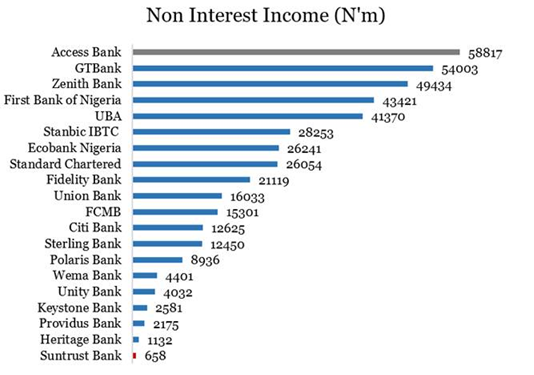
Source: H1 2019, financial statements of selected Nigerian banks, Proshare research
2.0 Breaking into Industry Numbers
The banking sector numbers for H1 2019 were a mix of the good, the bad and the splitting headaches.
2.1 Gross Earnings
Access Bank saw its gross earnings push up by +28.20% Y-o-Y on the back of its 2019 merger with Diamond Bank, the new and larger Access Bank appears to have been able to grow top line earnings as a desirable boon to the bank combination.
Table 3 Gross Earnings (GEs) of Selected Banks H1 2018- H1 2019
| Gross Earnings | ||||
| Bank | H1'19 (N'm) | H1'18 (N'm) | % Change | |
| Access Bank | 324,376 | 253,024 | 28.20% | |
| Ecobank (ETI) | 405,202 | 384,588 | 5.36% | |
| FBNH | 294,231 | 293,336 | 0.31% | |
| FCMB | 89,786 | 83,925 | 6.98% | |
| Fidelity Bank | 103,655 | 92,295 | 12.31% | |
| GT Bank | 221,870 | 226,632 | -2.10% | |
| Stanbic IBTC | 117,374 | 114,207 | 2.77% | |
| Sterling Bank | 74,499 | 77,608 | -4.01% | |
| UBA | 293,690 | 257,918 | 13.87% | |
| Union Bank | 76,017 | 83,333 | -8.78% | |
| Unity Bank | 20,547 | 17,492 | 17.47% | |
| Wema Bank | 40,835 | 32,034 | 27.47% | |
| Zenith Bank | 331,586 | 322,201 | 2.91% | |
| Source: Financial Statements of Nigerian Banks H1 2019 | ||||
Wema Bank grew top line by +27.47% on what seems to be a silent but effective growth in market share after an uncertain period of turning from a regional bank back to its previous national bank status. Segun Oloketuyi the bank's erstwhile managing director within a decade was able to turn around the fortunes of the failing institution before he retired in 2018. The new management led by Ademola Adebise apparently has consolidated on Oloketuyi's legacy.
Coming as a bit of a surprise, however, was the top line earnings decline of GTBank, Union Bank and Sterling Bank. GT Bank saw its GE fall from N226,6bn in H1 2018 to N221.9bn in H1 2019, a drop of -2.10%. The slide in GE happened despite a popularly held notion that GTBank has the fastest growing retail franchise in the country, especially in respect of its customer deposits growth. However, in a recent interview on a local television station, the bank's managing director, Segun Agbaje, noted that, "We are not in the business of corporate size but that of corporate profitability and scale; we are more about efficiency and productivity than about asset size and branch networks". Be that as it may, GTBank's top line dip still raises a few eyebrows as investors expect the bank to continue its history of top and bottom-line growth.
Union Bank, an older generation institution, slightly younger than the oldest bank in the country, FBN, has seen its fortunes in the last decade oscillate like a yo-yo. Between H1 2018 and H1 2019 the bank's gross earnings slipped -8.8% from N83.3bn in H1 2018 to N76.0bn in H1 2019.
Sterling Bank, a tier 2 institution, has been fingered as one of those smaller banks with a bright prospect to scale up to a tier 1 status in the near future, but the Y-o-Y decline in top line earnings between H1 2018 and H1 2019 does not bolster analyst's confidence. The bank's GE fell from N77.6bn in H1 2018 to N74.5bn in H1 2019, or -4.01%.
Other banks found their top line numbers somewhere between those that gained notches and those that suffered dips. FBNH's +0.31% rise in GE was below analyst's expectations and has brought to the fore questions about how well the bank's strategy for earnings growth and profitability were working to re-establish the group's prime position in the financial services sector. So far, the group's earnings have not risen to its aspirational watermark.
On the flipside, both UBA and Fidelity Bank appear to be elbowing towards a greater share of the local retail market as their GEs rose Y-o-Y by +29.6% and +15.6% respectively between H1 2018 and H1 2019. UBA's gross earnings rose from N257.9bn in H1 2018 to N293.7bn in H1 2019 reflecting the banks push to building stronger bottom line performance by expanding revenue and growing non-interest businesses which resulted in an advance in bottom line earnings; the bank's non-interest earnings grew +182.2% between Q1 and H1 2019.
Fidelity Bank's non-interest income over the contemporary period grew +80.28%. Fidelity bank edged into the space of the old Diamond Bank (before the Access Bank merger) to service the retail needs of traders in the eastern part of the country or individuals from the eastern part of the country. This enabled the bank add an additional layer of customer transaction value to its normal bread and butter activities.
Ecobank Transnational Inc. (ETI), StanbicIBTC, and FCMB saw more modest earnings growth between H1 2018 and H1 2019. ETI grew gross earnings over the period by +5.36%, StanbicIBTC by +2.77%, and FCMB by +6.98% (see Table 3 above).
2.2 Profitability
Banks between H1 2018 and H1 2019 had a mixed profit performance outlook. While some banks saw their profit before tax (PBT) rise between the two half years of 2018 and 2019, others witnessed noticeable drops. For example, GTBank saw its top line earnings (GE) slide over the period but its profit numbers remained impressive. GTBank posted the highest profit before tax in the industry for H1 2019 with a PBT of N115.8bn or +% higher than the N109.6bn posted in H1 2018.
Chart 3 Profit Before Tax of Selected Nigerian Banks H1 2019 (N'm)

| Source: Financial Statements of Nigerian Banks H1 2019 |
ZenithBank pulled up alongside GTB with the industry's second highest profit before tax in H1 2019 with a PBT of N111.7bn. Zenith Bank (similar to GT Bank) saw PBT rise by +% on a Y-o-Y basis. Access Bank after its consolidation with the old Diamond Bank has hauled its pre-tax profit in H1 2019 to N74.1bn, placing it in the position of third highest profit earner in the sector. In the profitability race GTBank appears to be the most profitable banking franchise in the country with a pre-tax earnings margin of 52.2%, followed by Stanbic IBTC with an earnings margin of 38.0%, and Zenith Bank with a margin of 33.7% (see table 4 below for other bank margins). Unity Bank had the lowest H1 2019 pre-tax earnings margin of 5.1%, with Wema Bank trailing closely behind with a margin of 6.4% (nevertheless, PBT for Wema actually grew by +43.7% Y-o-Y) and coming in from the rear with the third lowest margin was Sterling Bank, returning a margin of 8.1%.
Table 4 Pre-tax Profit Margins of Selected Banks Listed on the NSE
| Profit Margin | |||
| Banks | PBT(N'm) | Gross Earning (N'm) | Profit Margin |
| Unity Bank | 1,052 | 20,547 | 5.12% |
| Wema Bank | 2,608 | 40,835 | 6.39% |
| Sterling Bank | 6,001 | 74,499 | 8.06% |
| FCMB | 8,816 | 89,786 | 9.82% |
| FBNH | 39,871 | 294,231 | 13.55% |
| Fidelity Bank | 15,051 | 103,655 | 14.52% |
| Union Bank | 12,126 | 76,017 | 15.95% |
| Ecobank (ETI) | 73,434 | 405,202 | 18.12% |
| Access Bank | 74,116 | 324,376 | 22.85% |
| UBA | 70,274 | 293,690 | 23.93% |
| Zenith Bank | 111,677 | 331,586 | 33.68% |
| Stanbic IBTC | 44,650 | 117,374 | 38.04% |
| GTBank | 115,787 | 221,870 | 52.19% |
Source: Financial Statements of Nigerian Banks H1 2019
2.3 Cost to Income (CIR)-the Balancing Act
The tricky part of banking is keeping costs in check. Expansion of banking activities used to come with major increases in operating costs, or so it was thought. The new banking paradigm for success seems to approach business differently.
The lower a bank's cost to income ratio the better seems to be the state of its overall balance sheet and its capacity to withstand shocks. This would place GTBank at an advantage with its H1 2019 cost to income ratio of 37.6%, the lowest for the banking industry over the period. The second lowest CIR for banks listed on the NSE is that of Zenith Bank which posted a CIR of 50.3% or +12.7% higher than its GTBank counterpart.
Table 5 Cost to Income Ratios (CIR) of Nigerian Banks H1 2019
| Cost to Income Ratio | |
| Bank | CIR |
| GTBank | 37.63% |
| Zenith Bank | 50.28% |
| Stanbic IBTC | 53.17% |
| UBA | 60.00% |
| Access Bank | 60.95% |
| Ecobank (ETI) | 66.40% |
| FBNH | 70.52% |
| Fidelity Bank | 72.77% |
| FCMB | 73.50% |
| Union Bank | 76.27% |
| Sterling Bank | 80.30% |
| Unity Bank | 85.56% |
| Wema Bank | 86.29% |
Source: Financial Statements of Nigerian Banks H1 2019
StanbicIBTC slipped in as the third lowest CIR bank; a fact that is interesting from the perspective that the bank has a strong corporate banking footprint with a small retail market presence, suggesting that a low CIR is not necessarily a byproduct of a large retail market strategy. Wema Bank has the largest CIR for H1 2019 at 86.3% closely followed by Unity Bank with a CIR of 85.6% and Sterling Bank with a H1 2019 CIR of 80.3% (see table 5 above).
If data from bank returns to the CBN are to be taken into consideration the relative CIR position of banks (including those not listed on the NSE) looks different (see chart 4 below).
Chart 4 Cost to Income Ratio based on CBN Financial Statement returns, H1 2019
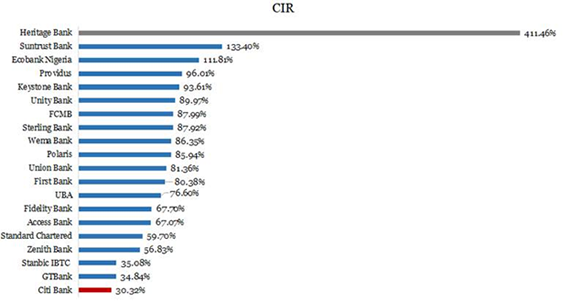
Source: Financial Statements of Nigerian Banks H1 2019, CBN
Heritage Bank has the highest cost to income ratio in Nigeria's banking sector with a CIR of 411.5%, suggesting that the bank's cost relative to its income is five times. In other words, the bank spends N5 in costs for every N1 of income it makes. The situation of a high CIR is one the bank must review quickly and reverse if it is to assure stakeholders of its operational sustainability (see Heritage Bank—Of Moral Hazards And The Unravelling Of A Deposit Money Institution). The second highest CIR on the basis of CBN reports is SunTrust Bank which had a CIR for H1 2019 of 133.4% or what amounts to over 100% of its income being swallowed up by operating expenses, this is a bit of a surprise as the bank is primarily digital with relatively low fixed asset costs thereby suggesting lower breakeven margin, notionally the bank should have a smaller CIR than many of its counterparts and its costs to income ratio should be somewhere around the industry median.
Although the bank's CIR is better than Heritage Bank's apparent cost challenges, the bank, however, has a pressing need to keep its headline costs trending towards the industry median of 83.7%. Coming from a H1 2019 CIR of 111.8%, ETI (Ecobank Transnational Inc.), equally has challenges keeping operational expenses down. The banking group has had a tough time bringing Nigerian operations at par with best group performance.
Other banks like Polaris Bank (CIR, 85.9%), Wema Bank (CIR, 86.4%), Sterling Bank (CIR, 87.9%), FCMB (CIR, 87.9%), Unity Bank (CIR, 89.9%), Keystone Bank (93.6%) and Providus Bank (CIR, 96.0%) all hover above the industry median making them vulnerable to general price increases or increases in administrative, marketing and advertising expenses. Cost containment as a generic competitive strategy, should come with the financial territory, banks need to face the technological and commercial imperative of lower costs and higher returns on investor equity. Unity Bank, for example, has had a number of challenges with its equity and costs. The bank's CIR of slightly below 90% needs to be pulled to about 60% over a period of two financial reporting seasons. The bank has already identified agriculture as a niche play and this enables it to tick off the strategic imperatives of focus and differentiation, but its weak equity position creates the problem of operational stability and high business risk (see infographic below).
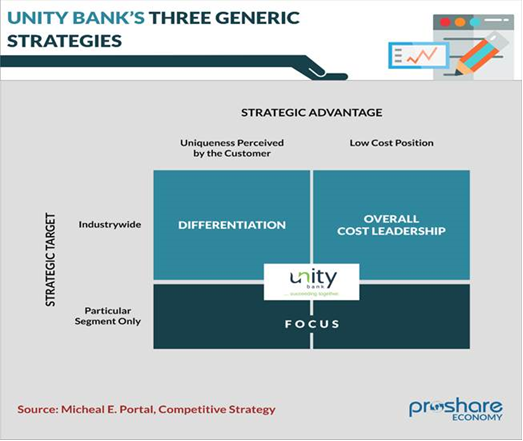
Unfortunately, generic strategies tend to have problems in environments where the rules of the competitive game are fluid, like when the game is no longer about brick and mortar competitiveness but the digital journey of customers and their expectations. The fact that banking has become a 'commoditized' service, a strategy of differentiation has become even harder to pursue for the likes of Unity Bank and its fellow tier 2 deposit money (DMB) counterparts.
2.4 Impairments
The clutch of 13 banks listed on the NSE have shown different impairment to loans ratio with the highest ratio in H1 2019 being that of FBNH with an impairment to loan ratio of 1.27% followed by FCMB with 0.89% and Zenith 0.76%. All the ratios were well within the CBN maximum guidance limit of 5%. The banks with the lowest ratios were GTBank 0.17%, Access Bank 0.18% and UBA 0.18%. This being said, some banks actually posted significant loan write-backs suggesting that they actually recovered previous loans considered lost. For example, Union Bank Plc had a write back of 0.85%, StanbicIBTC 0.12%, and Fidelity Bank 0.08%. The loan write-backs show up as negative impairment charges on analytical templates (see chart 5 below).
Chart 5 Impairment to Loan Ratio of Listed Banks on the NSE H1 2019
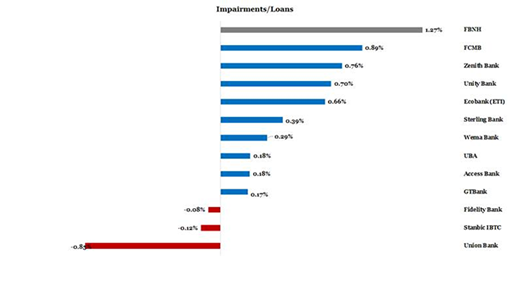
Source: Financial Statements of Nigerian Banks H1 2019
A detour into the H1 returns of banks to the CBN paints a slightly different picture.
Download Full H12019 Banking Sector PDF Report Here
Related Posts
1. UBA Pushes forFaster Growth; Top line Up 13.87% - Sept 22, 2019
2. GT Bank TargetsScale Not Size; H1 2019 Gross Earnings Down -2.1% - Sept 22,2019
3. FBNH SearchesFor Growth; H1 Operating Income Drops -0.3% - Sept 22,2019
4. ETI Works ItsCome Back, Gross Earnings Rises 5.36% - Sept 22, 2019
Related Links and References
Related News on Banking Sector
1. Banking Sector Update - Latest Cashless Initiative Largely Positive For Banks - Sep 18, 2019
2. Nigerian Banking Sector Recovery Still Hampered By Bad Loans - Jul 29, 2019
3. Banking Sector Update - Reviewed SDF Guidelines: Clear Intent; Minor Impact - Jul 12, 2019
4. Banking Sector Records 557.08m Volume of Transactions in Q1 2019 - NBS - May 31, 2019
5. The Many Headaches Of Keystone Bank - Underlying Pressures Persist - Mar 31, 2019
6. PDF: Heritage Bank - The Game Is Up: Time For A New Player With A Market GamePlan - Mar 2019
7. Nigeria: Macro-Economic and Banking Sector Themes For 2019 - Jan 28, 2019
8. How The Rules of The Game Are Changing in Africa's Banking Sector - Oct 28, 2018
9. Afrinvest Banking Sector Report Sets Agenda for New Government - Oct 17, 2018
10. FSDH Research Forecasts a Growth in the Banking Sector Credit to Private Sector - Apr 03, 2018
11. PDF: FBNH Performance Assesment Report 2017 H1 20171018 - Jun 2017
12. PDF: Analysing the Performance of FBN Holdings Plc - Mar 2017
13. Application of International Standard on Auditing (ISA) 701 in the Banking Sector - Feb 06, 2017
Related News On H1 2019 Corporate Results
- ACCESS Declares N63.03bn PAT in Q2 2019 Results; Proposes 25k Interim Dividend,(SP:N6.45k) - Sep 06, 2019
- UBA Declares N56.74bn PAT in Q2 2019 Results; Proposes 20k per share Interim Dividend,(SP:N5.85k) - Aug 30, 2019
- FIDELITYBK Declares N13.69bn PAT in Q2 2019 Results (SP:N1:66k) - Aug 30, 2019
- STANBIC Declares N36.25bn PAT in Q2 2019; Proposes N1.00 Interim Dividend,(SP:N35.00k) - Aug 28, 2019
- ZENITHBANK Declares N88.88bn PAT in Q2 2019 Results SP:N16.00k - Aug 20, 2019
- GUARANTY Declares N99.13bn PAT in Q2 2019 Results; Proposes N0.30kobo Interim Dividend,(SP:N25.75k) - Aug 16, 2019
- STERLNBANK Declares N5.66bn PAT in Q2 2019 Results,(SP:N2.24k) - Jul 31, 2019
- UNITYBNK Declares N967.51m PAT in Q2 2019 Results,(SP:N0.63k) - Jul 31, 2019
- UNITYBNK Declares N967.51m PAT in Q2 2019 Results,(SP:N0.63k) - Jul 31, 2019
- FBNH Declares N31.72bn PAT in Q2 2019 Results,(SP:N5.65k) - Jul 30, 2019
- UBN Declares N11.85bn PAT in Q2 2019 Results,(SP:N6.85K) - Jul 30, 2019
- FCMB Declares N7.53bn PAT in Q2 2019 Results, (SP:N1.65k) - Jul 29, 2019
- WEMABANK Declares N2.25bn PAT in Q2 2019 Results,(SP:N0.62k) - Jul 29, 2019
- ETI Declares N59.49bn PAT in Q2 2019 Results, (SP:N9.00k) - Jul 26, 2019
Related Links on Banks H1' 2019 Financial Reports
- Report for the Period ended 30th June 2019 - ACCESS Plc - Sep 06, 2019
- Report for the Period ended 30th June 2019 - UBA Plc - Aug 30, 2019
- Report for the Period ended 30th June 2019 - Fidelity Bank Plc - Aug 30, 2019
- Report for the Period ended 30th June 2019 - STANBIC IBTC - Aug 28, 2019
- Report for the Period ended 3oth June 2019 - ZENITHBANK Plc - Aug 20, 2019
- Report for the period ended 30th June 2019 - GTBANK Plc. - Aug 16, 2019
- Report for the Period ended 30th June 2019 - STERLNBANK Plc - Jul 31, 2019
- Report for the Period ended 30th June 2019 - UNITYBNK Plc - Jul 31, 2019
- Report for the Period ended 30th June 2019 - FBNH Plc - Jul 30, 2019
- Report for the Period ended 30th June 2019 - UBN Plc - Jul 30, 2019
- Report for the Period ended 30th June 2019 - FCMB Plc - Jul 29, 2019
- Report for the Period ended 30th June 2019 - WEMABANK Plc - Jul 29, 2019
- Report for the Period ended 30th June 2019 - ETI Plc - Jul 26, 2019
Most Recent Proshare Confidential Reports
- CEO Remuneration: Making Sense Of The Numbers For Listed Companies In Nigeria - Jul 12, 2019
- MTN Listing: Price Momentum Breaks on Rise In Traded Stocks; Proshare Writes Memo to Market - May 26, 2019
- Budget 2019: The Hidden Monsters - Feb 13, 2019
- Surviving Uncertain Times in the Nigerian Financial Market - Jan 19, 2019
- The Rich, The Poor and Buharinomics - Nov 23, 2018
- Nigerian Banks' Performance - H1 2018 - Sep 26, 2018
- AMCON and Financial Services Debt Burden in Nigeria - Aug 17, 2018
- Poverty Tracker and Nigeria: Raising The Red Flag - Jul 06, 2018
- POCKET Economics: Addressing Income Inequality - Jun 07, 2018
- The Silent Drug Epidemic: A Gathering Storm - May 03, 2018
- Judging IMF's Position on Development Indices - Apr 12, 2018
- Money Market: The Folk Road - Mar 05, 2018
- The Headache of Missing Targets - Jan 29, 2018
- 2018 Outlook on the Nigerian Economy: The Need for an Even Keel - Dec 29, 2017
- Nigeria External Economy and the White Noise of Import Dependency - Nov 29, 2017
 Lagos, NG • GMT +1
Lagos, NG • GMT +1










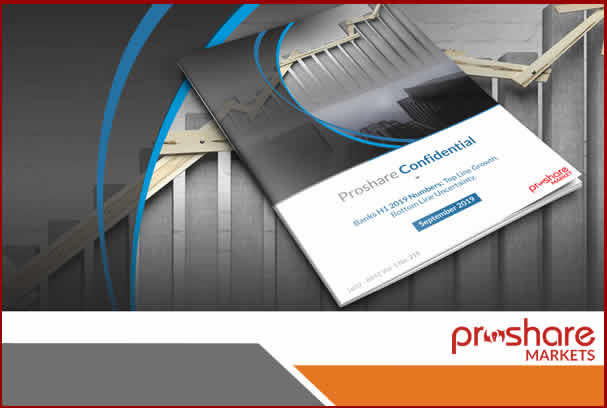
 7079 views
7079 views
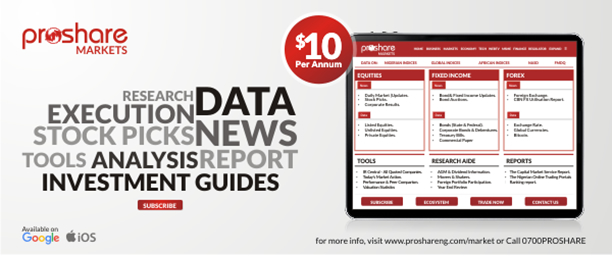







 Sponsored Ad
Sponsored Ad
 Advertise with Us
Advertise with Us









